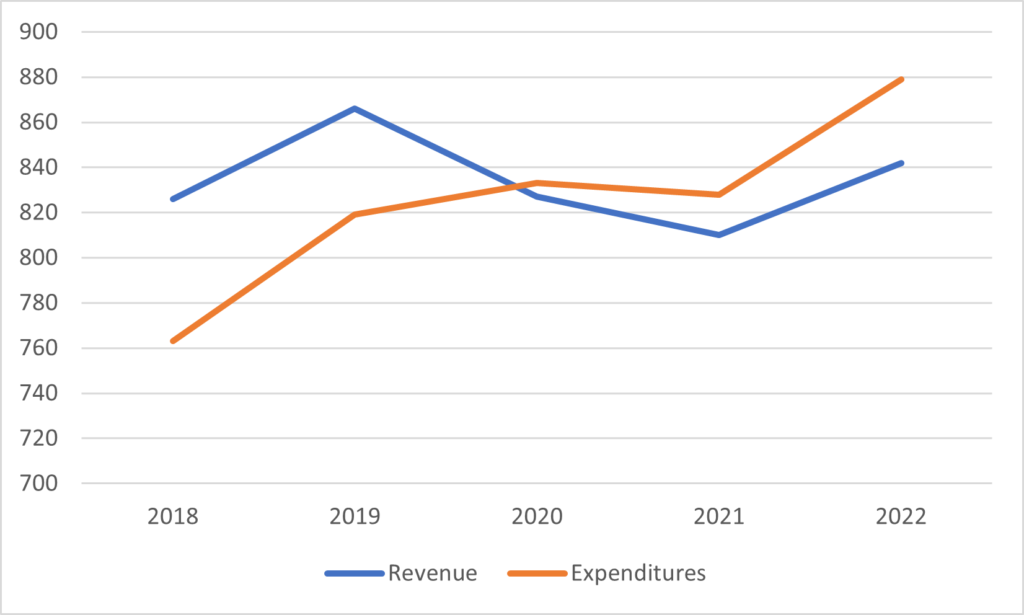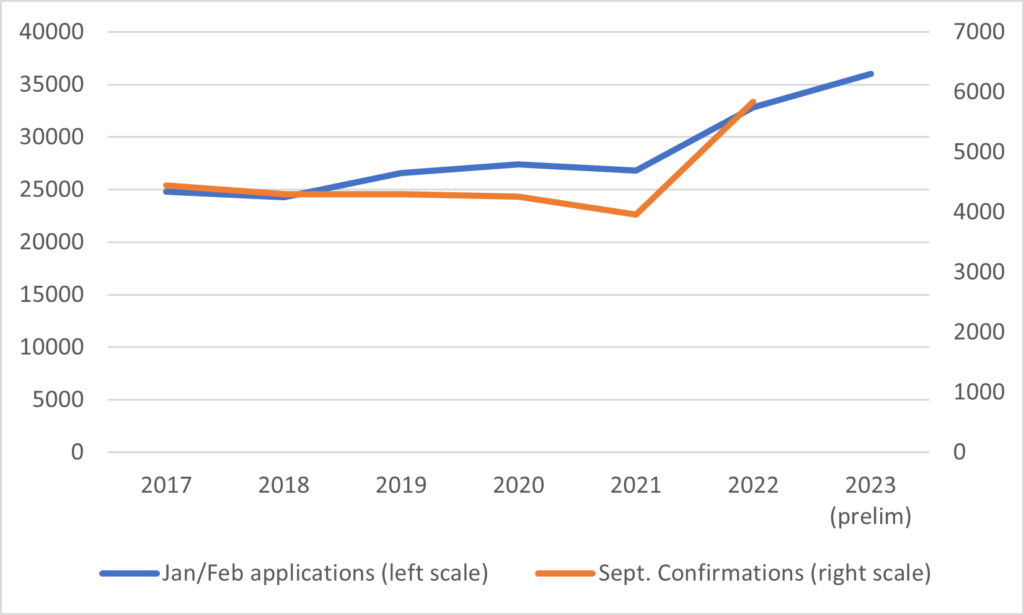The Ontario High School Application numbers dropped last week, and I thought it would be worth a quick tour of the data. Two things first:
First: I know folks from outside Ontario get cheesed off about the way I keep banging on about Ontario numbers, but here’s the thing: the rest of y’all don’t publish your data. I cannot write about hidden data: sorry.
Second: speaking of hidden data, the Ontario Universities Application Centre, for extremely flimsy reasons, has stopped publishing data on applications by field of study. The rationale is basically a combination of “the data isn’t 100% consistent from one institution to another” and “this can sometimes create situations where journalists write stories which are partly incorrect and embarrassing to institutions”. And so, in what is perhaps the most Canadian decision ever, instead of correcting the information, OUAC has decided to suppress it. Which means that informative graphs like this:
Figure 1: Informative Graph About Shares of Applications by Field of Study that Ontario Universities Don’t Want You to Have Anymore

can no longer be produced. If, as I do, you think this is an inane decision which embarrasses every university in the province, I suggest dropping a note to OUAC’s parent body, Council of Ontario Universities, at contact@ontariosuniversities.ca.
Anyways: on with the show.
Who Does Université de l’Ontario Français Serve?
You may recall that in its first year of existence, UOF received a grand total of 12 applications from Ontario high school students (two of which were first-choice applications, a statistic we can unfortunately no longer track because OUAC doesn’t feel like publishing it anymore). Of these applicants, 3 enrolled. That was terrible, but hey, it was Year One, plus COVID messed up the applications, so let’s give it a second chance. In its second year it went hard on recruiting and got…14 applications, of which 4 eventually enrolled. So, ok, back to the drawing board, maybe the problem is the nature of the programs they were offering (which, IMHO would look really cool to Masters-level students but are basically incomprehensible to first-year students), so throw in a new education program students will understand and get ready for year 3.
This year, UOF got 22 applications from Ontario secondary school students, an unknown number of which are first-choice. From which they *might* get six actual enrolments.
UOF made do in the first couple of years by going very heavy on international students (data is not available on exact enrolment numbers but it’s safe to say that a majority of students are international, perhaps as much as 75%), but this simply cannot go on. The $12 million or so per year the Government of Canada is giving to the institution runs out in 2024, and while in theory the Government of Ontario is on the hook for continuing this level of funding for another four years, that commitment was made on the basis of projections that domestic student numbers would be *much* higher than this and that international students would only form about 15% of enrolments. The entire logic of this institution was to serve a community which was seen as “underserved”, but the reaction from that community has been massively underwhelming. In practice, it appears most Franco-Ontarians did not think that the existing bilingual institutions (Ottawa, Laurentian and Glendon College at York) were so deficient after all. And now that Hearst has broken away from Laurentian to be a separate francophone institution, albeit also one with miniscule enrolment, it’s hard to see what role UOF plays except as a niche provider of international education. If they can make a go of it with that income base, great. But the rationale for large chunks of public funding grows thinner by the day.
Recovery at Laurentian and Big Jumps at Ontario Tech and Brock
Overall, applications were up 2.9% (individual applicant numbers were basically unchanged). But there were outliers. Laurentian saw its application numbers jump 10%, which is good news (although this is in the wake of a 43% drop the year previous – the university still has a ways to go). Ontario Tech and Brock are both on a roll – their total applications are both up strongly for a second year in a row, with the effect that they have two-year increases in applications of 58% and 26%, respectively (which is amazing). More generally, what we seem to be seeing is a small but significant shift away from big urban research universities.
Things are Going to Get Interesting at Guelph
Things are going to get interesting at Guelph. There’s been stuff going on at Guelph that hasn’t much caught the public eye, but this application round is going to make things interesting.
There are two pieces of backstory here. The first is that things are not going well financially at Guelph. Over the past five years, salaries and benefits have risen by about $80 million while there had been virtually no increase in total income (in real terms, 2021-2022 income was about 6% lower than 2017-18). While most other universities in the province have been raking in money on tuition fees – especially international ones – Guelph simply has stood pat.
Figure 2: University of Guelph Total Income and Expenditure, fiscal years 2017-18 to 2021-22

So, you can imagine how anxious Guelph was in 2021 when their incoming class numbers from Ontario fell. It wasn’t a matter of decreased interest – applications were pretty steady – it’s just that for whatever reason the 2021 application season didn’t see them convert in the usual numbers and the number of income first-year students for fall 2021 fell by about 7%. Combined with the deteriorating fiscal position, this must have been scary.
For 2022, they juiced up recruitment, and a) saw applications rise by 22%, b) lowered the threshold for “successful” applicants. So far so good. But then something unexpected happened: yield rates – that is, the percentage of students accepting places offered – also spiked. The upshot of all this? The number of incoming first-year domestic students from Ontario in 2022 jumped by 47%. Cue a lot of scrambling on campus trying to figure out how to house and teach all these students (a particular burden in the ever-more popular sciences where lab time is at a premium).
Figure 3: University of Guelph Applications and Confirmations (Ontario direct from secondary school only), 2017 to 2023

This year, applications at Guelph have jumped yet another 10%. This means that even if yield rates return to something like more historical levels, admissions cut-offs are going to have to rise significantly in order to bring student intake numbers back to somewhere like where they were three years ago. But will yield rates fall? Sometimes, when a school gets “hot”, they don’t. But institutions can’t know that in advance, and so much hinges on the admissions departments to hit a dimly-lit, moving target.
My best wishes to everyone there: this won’t be easy.

 Tweet this post
Tweet this post
